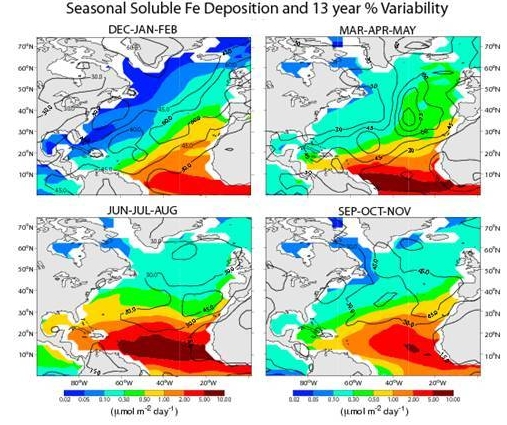Research Highlights February 2011: Moxim et al.
Study by Moxim and co-authors on The meteorological nature of variable soluble iron transport and deposition within the North Atlantic Ocean basin.
Biological
productivity in vast regions of the oceans is known to be limited by
the supply of iron, an essential nutrient to marine organisms,
impacting carbon export to the ocean floor. The atmospheric source of
iron originates from desert mineral dust aerosols and is converted to
a bio-available form of soluble iron during transport. Little is
known of the magnitude and variability of soluble iron deposition
(SFeD) and the character of its transport. We have used the GFDL
Global Chemical Transport Model to examine the emission of mineral
dust (~3.5% Fe) during Saharan desert dust storms; the chemical
processing of iron to a soluble form during transport; and the
subsequent dry surface deposition and precipitation scavenging
deposition to the North Atlantic Ocean.
The
following figure presents the seasonal SFeD magnitude (color shading)
and variability (contour lines). The bulk of the North Atlantic Ocean
receives its maximum soluble iron deposition during summer while the
greatest deposition in the northeast Atlantic is found during March
through May coincident with the observed spring phytoplankton bloom.
The largest seasonal flux (> 5 µmol m-2
day-1;
450 µmol m-2
season-1)
occurs in the subtropics during summer when dust is transported
westward off Africa by steady trade winds as seen by the relatively
low (< 30%) variability. During winter and spring large year to
year variability (> 60%) is seen in the central Atlantic from
north of the Caribbean to the west of Europe. Regionally, a near
absence of SFeD during some years and large episodes during other
years produces very high variability (> 75%) as depicted in the
central north Atlantic.

The
nature of dry and wet deposition can be quite different. The figure
below depicts a time series of daily dry and wet SFeD during July and
March for a grid box off the coast of West Africa. During July there
are five distinct pulses of SFeD (up to 14 µmol m-2
day-1)
associated with intermittent dust outbreaks and wet removal in the
Intertropical Convergence Zone (ITCZ). In March, however, the ITCZ
precipitation maxima is located south of the grid box so that SFeD is
controlled by comparatively slow evolving surface dry removal
containing two broad lower magnitude peaks.

Note
that the short-term episodes of SFeD during precipitation events
(July) can be significantly larger than the monthly mean rate
(straight line). Analysis shows this to be true throughout the entire
Atlantic Ocean. However, it remains unclear what the effects of
episodic natural soluble iron fertilization are on the initiation and
growth of phytoplankton blooms and air-sea CO2
exchange.


